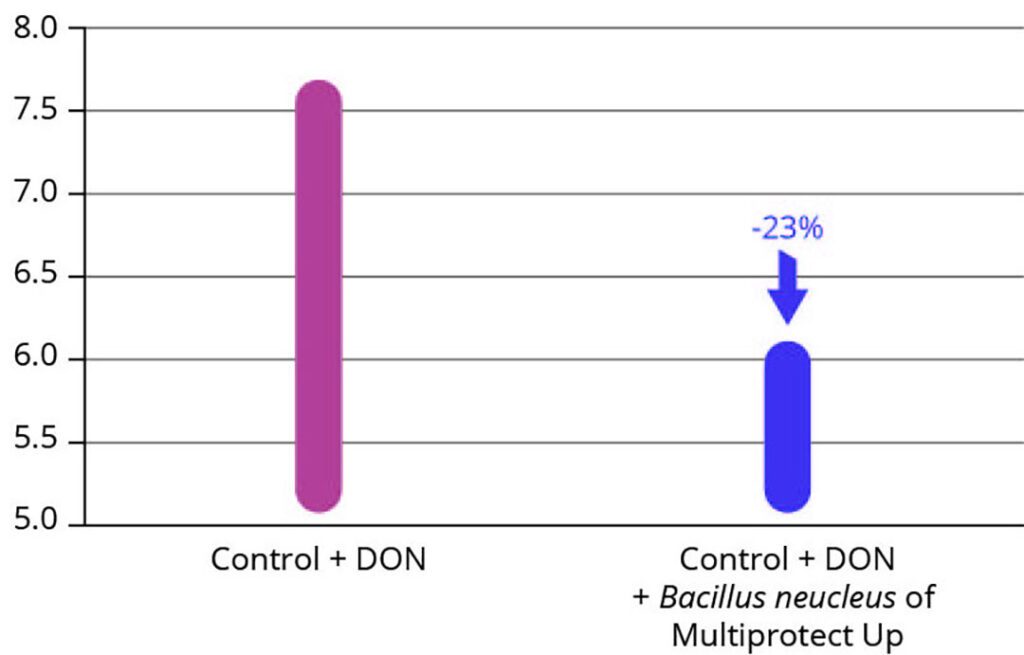Strategies to reduce biotoxin impact on animals

Mycotoxins are toxic secondary metabolites produced by fungi, which pose a persistent threat to animal health and performance due to their widespread presence in feed. The use of innovative “in-feed” solutions is imperative to counteract the detrimental effects of mycotoxins on animals. As the feed industry confronts new challenges, it is crucial to go from basic toxin binders to more sophisticated and comprehensive solutions.
MYCOTOXIN SPECIAL 2023 – read all articles
Talking about biotoxins, is to consider the risk of mycotoxins, but also of bacterial toxins. Climate change and an improved understanding of mycotoxin contamination and toxicity demand innovative solutions for maintaining optimal animal health, performance and well-being. The challenges posed by mycotoxins include the ever-increasing global prevalence, the emergence of new, more toxic mycotoxin variants, and the under-explored concept of multi-contamination exacerbating individual mycotoxin effects.The risk of bacterial toxins is widely present although difficult to assess (presence and level of contamination), being linked to environmental and health conditions. Thus, it is recognised that animals are constantly confronted with high levels, for example lipopolysaccharides (LPS) in ruminants. Bacterial toxins (endotoxins and exotoxins) are involved in the development of many diseases. Moreover, the correlation between these two type of biotoxins is to consider: in a challenged situation with mycotoxins, the animal contaminated by bacterial toxins is more likely to develop a serious pathology related to them.It is therefore, essential to consider biotoxins contamination, as a whole through a holistic approach.
Strategies to mitigate biotoxins effects
To face the pervasive and hazardous nature of biotoxin contamination, various strategies have been employed to minimise their adverse effects on animals.
![]() Decreasing bioavailability: Adsorption and biodegradation
Decreasing bioavailability: Adsorption and biodegradation
The aim of these strategies is to reduce mycotoxin exposure by limiting their uptake and distribution in animals. Adsorbing agents, such as silica-based compounds and carbon-based organic polymers, bind biotoxins preventing their absorption and promoting elimination through faeces. The efficacy of these agents varies, especially concerning their interactions with other nutrients and contaminants. Innovatively, microorganisms or enzymes capable of detoxifying mycotoxins through metabolisation or degradation can be utilised. Bacillus strains, for example, have shown significant potential in degrading mycotoxins and their derivatives. These approaches offer specificity, irreversibility, and eco-friendliness in detoxification processes.
![]() Bioprotection for overall animal health
Bioprotection for overall animal health
Bioprotection entails employing various mechanisms and compounds to enhance animal health while countering mycotoxin effects. This involves antioxidant agents, immunostimulants, amino acids, and molecules that support organ function without interference from toxins. Strengthening intestinal barriers and tight junctions further restrict the passage of toxins into the body.
Pigs, for instance, can benefit from bioprotection against deoxynivalenol (DON), a mycotoxin known to impair immune response and gut health. Bacillus supplementation (Nolivade, France) in piglets has shown promise in limiting DON passage into the bloodstream, thereby improving weight gain and overall performance (Figure 1).
Figure 1 – DON (µg/L) in piglets’ serum at 21 days.

Synergistic approaches
Considering the complexity of mycotoxin presence, their levels, and the various environmental stressors animals face, a synergistic approach combining complementary actions is optimal. MiXscience’s product, Multiprotect Up, exemplifies this approach, blending selected ingredients to deliver multiple modes of action, including adsorption, biodegradation, and bioprotection. This comprehensive strategy supports animals in coping with diverse mycotoxin challenges and contributes to enhance health and performance.
Beneficial effects of Multiprotect Up can be illustrated by a study conducted in Ivory Coast focused on broilers and utilised locally sourced raw materials that were naturally exposed to mycotoxins. These mycotoxins primarily included aflatoxins, fumonisins (FB1 and FB2), and deoxynivalenol, with concentrations reaching 0.8, 1.7, and 0.05 mg/kg of finished feed, respectively. Comparing the supplemented group to the control group, the study revealed significant improvements. The supplemented group exhibited a noteworthy increase in body weight (+60g; +3%), a decrease in mortality, and a significant reduction in aspartate aminotransferase levels at day 21, as indicated by blood analysis (Figure 2). This decrease in aspartate aminotransferase levels can be associated to liver health.
Figure 2 – Level of aspartate aminotransferase (U/L) in broiler serums at Day 21.

The beneficial effects of Multiprotect Up were observed in another production context, as illustrated in the results from a commercial duck trial in Vietnam, with the enhancement of performance and a significant decrease in mortality rate (Figure 3). This trial lasted 46 days, involved a total of 23,440 animals divided into two groups, both receiving a naturally challenged local feed containing DON and T2 Toxin, at levels of 0.5 ppm and 39 ppb, respectively.
Figure 3 – Percentage of mortality (%) of ducks during the trial period.

Progress with comprehensive strategies
As the prevalence of biotoxins remains an inevitable aspect of animal feed, their management is essential for animal health and productivity. The integration of carefully selected ingredients offering diverse modes of action, such as mycotoxin adsorption, biodegradation, and bioprotection, contributes to enhanced animal health, well-being, and performance. The evolving challenges posed by mycotoxins necessitate innovative solutions that go beyond conventional approaches, safeguarding animals from their adverse effects in an increasingly complex environment.
 Beheer
Beheer





 WP Admin
WP Admin  Bewerk bericht
Bewerk bericht